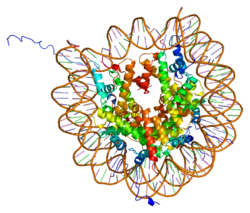| H2AC1 |
|---|
 |
| Identificadores |
|---|
| Nomes alternativos | H2AC1 |
|---|
| IDs externos | OMIM: 613499 HomoloGene: 108269 GeneCards: H2AC1 |
|---|
| Ontologia genética |
|---|
| Função molecular | • protein heterodimerization activity
• DNA binding
|
|---|
| Componente celular | • nucleossoma
• núcleo celular
• cromossoma
• Exossoma
|
|---|
| Processo biológico | • GO:0031497, GO:0006336, GO:0034724, GO:0001301, GO:0007580, GO:0034652, GO:0010847 chromatin organization
|
|---|
| Sources:Amigo / QuickGO |
|
|
| Ortólogos |
|---|
| Espécie | Humano | Rato |
|---|
| Entrez | | |
|---|
| Ensembl | | |
|---|
| UniProt | | |
|---|
| RefSeq (mRNA) | | |
|---|
| RefSeq (proteína) | | |
|---|
| Localização (UCSC) | n/a | n/a |
|---|
| Pesquisa PubMed | [1] | n/a |
|---|
|
| Wikidata |
|
A Histona H2A tipo 1-A é uma proteína que em humanos é codificada pelo gene HIST1H2AA.[2][3]
As histonas são proteínas nucleares básicas que são responsáveis pela estrutura dos nucleossomos da fibra cromossômica nos eucariotos. Duas moléculas de cada uma das quatro histonas do núcleo (H2A, H2B, H3 e H4) formam um octâmero, em torno do qual aproximadamente 146 pb de DNA é envolvido em unidades repetidas, chamadas nucleossomos. A histona ligante, H1, interage com o DNA ligante entre nucleossomos e funciona na compactação da cromatina em estruturas de ordem superior. Este gene é desprovido de intrones e codifica um membro da família histona H2A. Os transcritos desse gene não possuem caudas de poli A, mas contêm um elemento de terminação palindrômica. Este gene é encontrado no pequeno agrupamento de genes de histonas no cromossomo 6.[3]
Leitura adicional
- El Kharroubi A, Piras G, Zensen R, Martin MA (1998). «Transcriptional Activation of the Integrated Chromatin-Associated Human Immunodeficiency Virus Type 1 Promoter». Mol. Cell. Biol. 18 (5): 2535–44. PMC 110633
 . PMID 9566873. doi:10.1128/mcb.18.5.2535
. PMID 9566873. doi:10.1128/mcb.18.5.2535 - Deng L, de la Fuente C, Fu P, et al. (2001). «Acetylation of HIV-1 Tat by CBP/P300 increases transcription of integrated HIV-1 genome and enhances binding to core histones». Virology. 277 (2): 278–95. PMID 11080476. doi:10.1006/viro.2000.0593
- Deng L, Wang D, de la Fuente C, et al. (2001). «Enhancement of the p300 HAT activity by HIV-1 Tat on chromatin DNA». Virology. 289 (2): 312–26. PMID 11689053. doi:10.1006/viro.2001.1129
- Strausberg RL, Feingold EA, Grouse LH, et al. (2003). «Generation and initial analysis of more than 15,000 full-length human and mouse cDNA sequences». Proc. Natl. Acad. Sci. U.S.A. 99 (26): 16899–903. PMC 139241
 . PMID 12477932. doi:10.1073/pnas.242603899
. PMID 12477932. doi:10.1073/pnas.242603899 - Mungall AJ, Palmer SA, Sims SK, et al. (2003). «The DNA sequence and analysis of human chromosome 6». Nature. 425 (6960): 805–11. PMID 14574404. doi:10.1038/nature02055
- Lusic M, Marcello A, Cereseto A, Giacca M (2004). «Regulation of HIV-1 gene expression by histone acetylation and factor recruitment at the LTR promoter». EMBO J. 22 (24): 6550–61. PMC 291826
 . PMID 14657027. doi:10.1093/emboj/cdg631
. PMID 14657027. doi:10.1093/emboj/cdg631 - Zhang Y, Griffin K, Mondal N, Parvin JD (2004). «Phosphorylation of histone H2A inhibits transcription on chromatin templates». J. Biol. Chem. 279 (21): 21866–72. PMID 15010469. doi:10.1074/jbc.M400099200
- Aihara H, Nakagawa T, Yasui K, et al. (2004). «Nucleosomal histone kinase-1 phosphorylates H2A Thr 119 during mitosis in the early Drosophila embryo». Genes Dev. 18 (8): 877–88. PMC 395847
 . PMID 15078818. doi:10.1101/gad.1184604
. PMID 15078818. doi:10.1101/gad.1184604 - Wang H, Wang L, Erdjument-Bromage H, et al. (2004). «Role of histone H2A ubiquitination in Polycomb silencing». Nature. 431 (7010): 873–8. PMID 15386022. doi:10.1038/nature02985
- Gerhard DS, Wagner L, Feingold EA, et al. (2004). «The Status, Quality, and Expansion of the NIH Full-Length cDNA Project: The Mammalian Gene Collection (MGC)». Genome Res. 14 (10B): 2121–7. PMC 528928
 . PMID 15489334. doi:10.1101/gr.2596504
. PMID 15489334. doi:10.1101/gr.2596504 - Hagiwara T, Hidaka Y, Yamada M (2005). «Deimination of histone H2A and H4 at arginine 3 in HL-60 granulocytes». Biochemistry. 44 (15): 5827–34. PMID 15823041. doi:10.1021/bi047505c
- Cao R, Tsukada Y, Zhang Y (2006). «Role of Bmi-1 and Ring1A in H2A ubiquitylation and Hox gene silencing». Mol. Cell. 20 (6): 845–54. PMID 16359901. doi:10.1016/j.molcel.2005.12.002
- Bergink S, Salomons FA, Hoogstraten D, et al. (2006). «DNA damage triggers nucleotide excision repair-dependent monoubiquitylation of histone H2A». Genes Dev. 20 (10): 1343–52. PMC 1472908
 . PMID 16702407. doi:10.1101/gad.373706
. PMID 16702407. doi:10.1101/gad.373706
Referências
- ↑ «Human PubMed Reference:»
- ↑ Marzluff WF, Gongidi P, Woods KR, Jin J, Maltais LJ (outubro de 2002). «The human and mouse replication-dependent histone genes». Genomics. 80 (5): 487–98. PMID 12408966. doi:10.1016/S0888-7543(02)96850-3
- ↑ a b «Entrez Gene: HIST1H2AA histone cluster 1, H2aa»
 | Este artigo sobre Genética é um esboço. Você pode ajudar a Wikipédia expandindo-o. |
 Portal da genética
Portal da genética Portal da bioquímica
Portal da bioquímica

 . PMID 9566873. doi:10.1128/mcb.18.5.2535
. PMID 9566873. doi:10.1128/mcb.18.5.2535  . PMID 12477932. doi:10.1073/pnas.242603899
. PMID 12477932. doi:10.1073/pnas.242603899  . PMID 14657027. doi:10.1093/emboj/cdg631
. PMID 14657027. doi:10.1093/emboj/cdg631  . PMID 15078818. doi:10.1101/gad.1184604
. PMID 15078818. doi:10.1101/gad.1184604  . PMID 15489334. doi:10.1101/gr.2596504
. PMID 15489334. doi:10.1101/gr.2596504  . PMID 16702407. doi:10.1101/gad.373706
. PMID 16702407. doi:10.1101/gad.373706 
 Portal da genética
Portal da genética Portal da bioquímica
Portal da bioquímica














